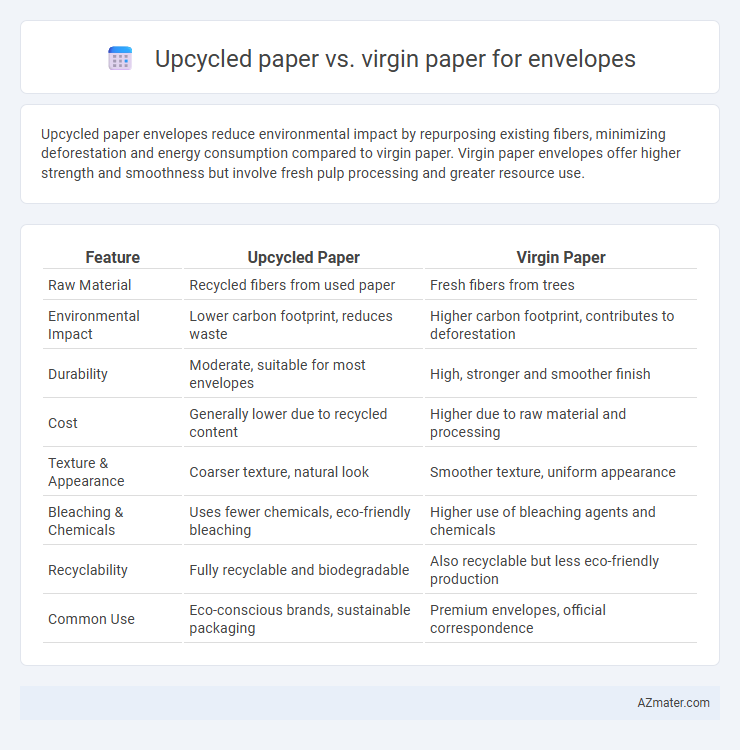Upcycled paper envelopes reduce environmental impact by repurposing existing fibers, minimizing deforestation and energy consumption compared to virgin paper. Virgin paper envelopes offer higher strength and smoothness but involve fresh pulp processing and greater resource use.
Table of Comparison
| Feature | Upcycled Paper | Virgin Paper |
|---|---|---|
| Raw Material | Recycled fibers from used paper | Fresh fibers from trees |
| Environmental Impact | Lower carbon footprint, reduces waste | Higher carbon footprint, contributes to deforestation |
| Durability | Moderate, suitable for most envelopes | High, stronger and smoother finish |
| Cost | Generally lower due to recycled content | Higher due to raw material and processing |
| Texture & Appearance | Coarser texture, natural look | Smoother texture, uniform appearance |
| Bleaching & Chemicals | Uses fewer chemicals, eco-friendly bleaching | Higher use of bleaching agents and chemicals |
| Recyclability | Fully recyclable and biodegradable | Also recyclable but less eco-friendly production |
| Common Use | Eco-conscious brands, sustainable packaging | Premium envelopes, official correspondence |
Understanding Upcycled Paper and Virgin Paper
Upcycled paper for envelopes is made from recycled materials, reducing environmental impact by conserving trees and lowering energy consumption during production. Virgin paper, derived directly from fresh wood pulp, offers higher durability and uniformity but involves more resource-intensive manufacturing processes. Selecting between upcycled and virgin paper balances eco-friendly benefits with performance needs in envelope production.
Environmental Impact of Upcycled vs Virgin Paper
Upcycled paper envelopes significantly reduce deforestation and energy consumption compared to virgin paper envelopes by reusing existing fibers and minimizing the need for raw materials. Virgin paper production often involves high water usage, chemical treatments, and greenhouse gas emissions that contribute to environmental degradation. Choosing upcycled paper for envelopes supports waste reduction and lowers carbon footprint, making it a more sustainable option in paper manufacturing.
Production Processes: Upcycled vs Virgin Paper
Upcycled paper for envelopes is produced by repurposing post-consumer or post-industrial waste, significantly reducing energy and water consumption compared to virgin paper, which relies on fresh wood pulp from trees. The production process of virgin paper involves chemical pulping and bleaching, contributing to higher carbon emissions and deforestation. Upcycled paper manufacturing minimizes environmental impact by diverting waste from landfills and utilizing eco-friendly techniques, making it a sustainable choice for envelope production.
Resource Consumption and Sustainability
Upcycled paper envelopes significantly reduce resource consumption by utilizing post-consumer waste, thereby minimizing the need for virgin fiber extraction and lowering water and energy usage during production. Virgin paper envelopes rely on freshly harvested timber, contributing to deforestation, higher greenhouse gas emissions, and increased water consumption. Choosing upcycled paper supports sustainability by diverting waste from landfills and decreasing the overall environmental footprint associated with paper manufacturing.
Quality and Performance in Envelope Making
Upcycled paper envelopes offer comparable durability and print clarity to virgin paper while significantly reducing environmental impact by reusing fiber content. Virgin paper provides consistent texture and strength due to its pure, unprocessed fibers, resulting in superior moisture resistance and crease retention essential for high-quality envelope manufacturing. Both materials support professional envelope performance, but virgin paper excels in premium applications requiring enhanced longevity and structural integrity.
Cost Comparison: Upcycled vs Virgin Paper
Upcycled paper for envelopes typically incurs lower production costs due to reduced raw material expenses compared to virgin paper, which requires freshly harvested pulp and more energy-intensive processing. Virgin paper envelopes, while often offering higher durability and brightness, come with increased manufacturing costs linked to forestry, chemical treatments, and water usage. Businesses aiming to minimize expenses and environmental impact may find upcycled paper envelopes a cost-effective alternative without significantly compromising quality.
Aesthetic Differences in Envelope Appearance
Upcycled paper envelopes exhibit a rich, textured surface with visible fibers and slight color variations, imparting a unique, handcrafted aesthetic that appeals to eco-conscious consumers. Virgin paper envelopes generally present a smooth, uniform finish with consistent color and brightness, lending a polished, professional look ideal for formal correspondence. The natural imperfections and organic hues of upcycled paper create distinctive visual interest, while virgin paper's crispness ensures a clean and classic envelope appearance.
Recyclability and End-of-Life Considerations
Upcycled paper envelopes offer enhanced recyclability due to their reduced chemical processing and lower contamination levels compared to virgin paper, enabling smoother recycling streams. Virgin paper envelopes, derived from freshly harvested fibers, often require intensive bleaching and chemical treatments that can complicate recycling and increase environmental impact during disposal. End-of-life considerations favor upcycled paper for its minimized landfill burden and improved biodegradability, aligning with sustainable waste management practices.
Certifications and Eco-Labels to Look For
Upcycled paper envelopes often carry certifications such as FSC Recycled or the Blue Angel label, indicating the use of post-consumer waste and environmental responsibility. Virgin paper envelopes typically feature FSC or PEFC certifications, ensuring sustainable forest management and responsible sourcing. Key eco-labels to prioritize include Cradle to Cradle, Green Seal, and EU Ecolabel, which verify reduced environmental impact throughout the production process for both paper types.
Choosing the Best Paper for Eco-Friendly Envelopes
Upcycled paper envelopes reduce waste by reusing post-consumer materials, significantly lowering carbon footprints compared to virgin paper, which requires extensive tree harvesting and energy-intensive processing. Virgin paper offers higher durability and smoothness but at a greater environmental cost due to deforestation and chemical use. Choosing upcycled paper supports sustainable practices by conserving natural resources and minimizing landfill contribution while maintaining adequate quality for eco-friendly envelope production.

Infographic: Upcycled paper vs Virgin paper for Envelope
 azmater.com
azmater.com